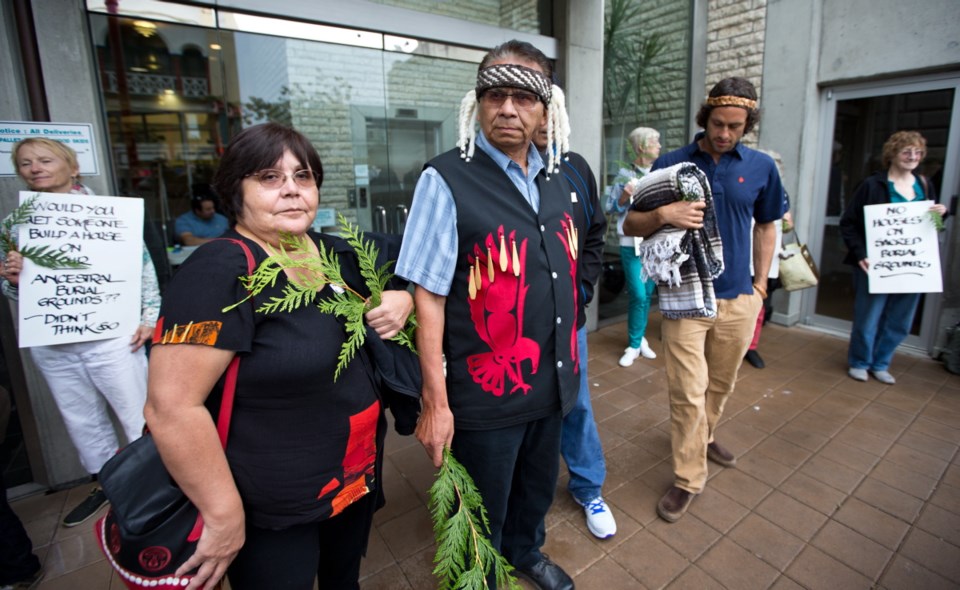[UPDATE] The Capital Regional District has decided not to expropriate privately owned Grace Islet.
Previous story
Capital Regional District directors debated expropriating privately owned Grace Islet to protect it as a park reserve in a closed meeting on Wednesday, but will not announce the results of the meeting until later this week.
“In the absence of provincial action, I’m suggesting we use the powers we have,” said Ben Isitt, the CRD director and Victoria councillor who introduced the expropriation motion.
Grace Islet in Ganges Harbour is home to a documented First Nations burial ground. It was bought in 1990 for $270,000 by Alberta businessman Barry Slawsky, whose plans to build a retirement home were stalled when human remains, bone fragments and burial cairns were identified in 2006. In 2014, the land was assessed at $590,000, which does not represent its market value.
Though Slawsky has followed the process for landowners wanting to build on archeological sites and obtained the necessary permits from the province, First Nations concerns over what they see as desecration of the burial ground has escalated as construction continues.
“This is a very difficult situation for the board to be in, but [Forests Minister Steve Thomson] is sitting on his hands on this,” said Gary Holman, NDP MLA for Saanich North and the Islands. “He should have suspended the permits a year ago when they were clearly violated.”
Slawsky breached permit conditions issued by the B.C. Archaeology Branch, the body responsible for protecting remains under the Heritage Act, in 2012 by not having a professional archeologist on site during clearing.
Recent concerns over changing building plans and photos that appear to show concrete encasing and buttressing cairns were acknowledged by Archaeology Branch staff who visited the site last month, but the site-alteration permits have not been suspended.
With the province unwilling to act, Holman said, the CRD might be the end of the bureaucratic line in stopping — or at least slowing — development of Grace Islet to address First Nations concerns.
In public addresses to the board prior to the in-camera meeting, Holman said, “If you initiate this [expropriation], you will not be alone.”
He noted protecting the islet falls within the CRD’s mandate to preserve native plants in parks and work with First Nations. Saltspring Island residents have a strong history in generating the momentum and raising the funds to protect lands, he added.
Victoria lawyer John Alexander represented Slawsky at the meeting. He said the board has not sufficiently considered the facts, including that his client has followed all his legal obligations. He asked to address the meeting regarding expropriation.
“When you buy a piece of land, you feel entitled to continue to own it. Certainly, governments have expropriation powers and they have used them in the past. I have been involved in dozens and dozens of expropriation cases. They are quite emotional. It’s not easy to throw someone out of their house,” Alexander said outside the meeting.
He noted that expropriation proceedings are complicated, costly and can last years.
“My client is proceeding on the basis of the archeological advice he has been given. … He has been simply following that without taking any philosophical position as to whether something should be called a burial or a bone or a heritage object,” he said, adding his client has respect for First Nations rights.
Archeologists Eric McLay and Darcy Mathews, who have worked on Grace Islet, presented evidence of human remains and burial cairns in defence of protecting it.
“Grace Islet has not been sufficiently examined by qualified archeologists,” said Mathews, who believes there are more unidentified burials on the property and recommended the province seek a review from a third-party archeological expert.
“Maintaining the integrity of a cemetery is as important as maintaining the burials themselves.”
Chiefs from Tsartlip, Tseycum and Cowichan tribes, as well as other First Nations representatives, reiterated their concerns.
“It’s appalling that it’s got to this point on Grace Islet,” said Tsartlip chief Don Tom, adding the issue is personal as his ancestors also come from Chemainus and Saltspring Island. “When you build on gravesites and sacred cairns, there is no dignity in death.”




